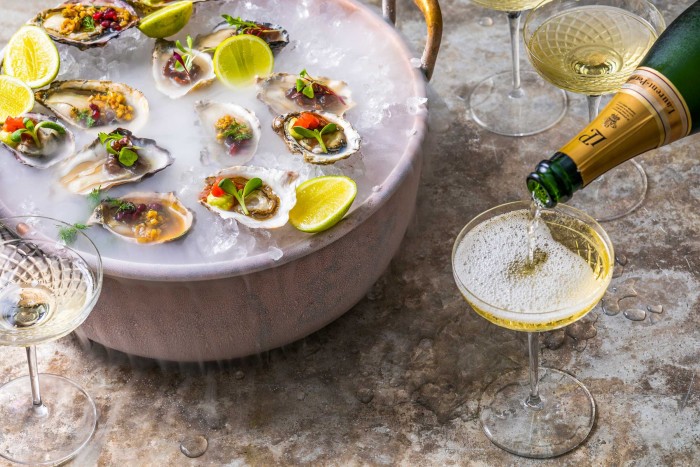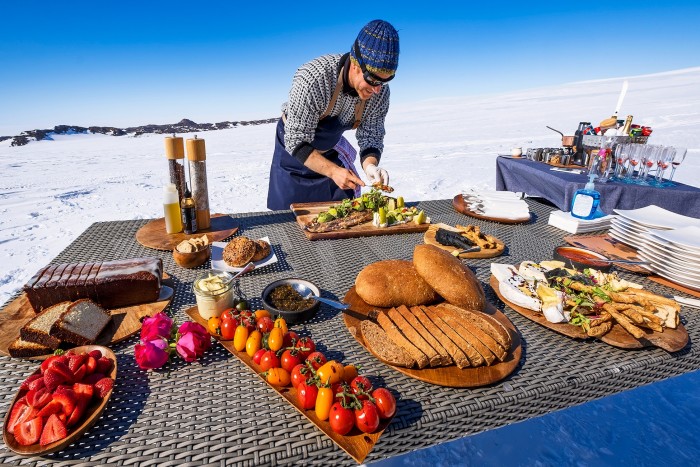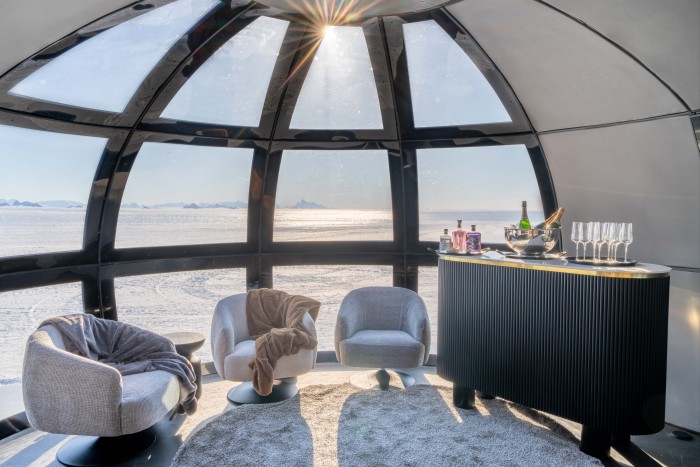Dinner is served, at -25°C

Roula Khalaf, Editor of the FT, selects her favourite stories in this weekly newsletter.
Cooking up a Michelin-worthy meal at an out-of-the-way luxury hotel is challenging at the best of times. There are peculiar diets to deal with, and high-maintenance guests who won’t settle for less than the very best. But throw in a location that is permanently frozen, and where your kitchen is closer to the International Space Station than to the nearest supermarket, and supply logistics turn hairy.?
Those are the challenges chefs at White Desert face when preparing menus for the 300 or so guests who check in at its luxury and adventure camps every Antarctic summer season, which lasts from mid-November to early February. Located in Queen Maud Land in east Antarctica, each camp comprises six pod-like bedrooms in the icy wilderness and are only reachable by guests via a chartered five-and-a-half-hour flight from Cape Town. Much of the cargo arrives by polar supply ship and requires another 800km overland haul. A can of Coca-Cola has racked up $37 in transport costs by the time it’s cracked open at the camps’ communal dining table.

But despite White Desert’s remoteness, its guests don’t have to subsist on bannock and pemmican. Days might start with parmesan-flecked mushrooms and eggs on toast, or shakshuka spiked with Danish feta and fresh basil. Lunch could include herb-crusted salmon or ricotta ravioli, while glacier hikes or emperor-penguin safaris come with packed gourmet sandwiches and thermoses of creamy tomato soup. Evenings begin with chilled avocado gazpacho or crostini with duck-liver parfait, all served alongside glacier ice-cooled cocktails. These segue into multi-course dinners that range from artfully plated duck confit to family-style Indian feasts featuring silky butter chicken.?
The team has cooked in similarly remote kitchens at the Everest Base Camp and the Elbrus Base Camp in Russia. Aside from food for the guests, they have to prepare about 22,000 meals for the 150 staff each season, so preparations begin in April, months before the first adventurers arrive every November.


From a central kitchen in Cape Town, the team oversees the creation and shipping of almost 45 tonnes of food cargo per season. Where possible, components of meals – such as boeuf bourguignon, garlicky mashed potatoes, croissant dough or meringue – are premade and frozen, then stored in naturally cold “igloo” freezers at White Desert’s base camp before being cooked and plated. Eggs, vegetables, and other fresh ingredients, along with any last-minute guest requests, come in on the weekly flight from Cape Town and are kept in faux-fur insulated boxes to keep them from freezing, while glacier ice, melted and double-filtered, provides the drinking water.?
“We’ve spent years refining our menus to see how different ingredients react to freezing, and regularly test all meals for taste and visual appeal,” Louis Jansen Van Vuuren, food & beverage manager on my trip, told me. Much like on an aeroplane, the extreme dryness of the continent’s atmosphere affects key taste receptors such as nasal mucus. To balance those lowered taste profiles, dishes are deliberately robust, drawing heavily on bold flavours from the Thai, Indian and Greek kitchens. Additional salt makes up for the seasoning flavours lost during the freezing process.?

Wine, of course, flows freely: both at the dining table in the camps’ heated communal lounge, or in the igloo-like ice bar at the base camp. But pairing each dinner with the perfect pour isn’t straightforward. “A premium wine bottle usually weighs about a kilo,” says Ingrid Motteux, founder of Cape Town-based wine consultancy Winewise, who has curated the camps’ concise but compelling wine list. “Transporting individual bottles would not only increase the plane’s payload but also require flying the empties back to Cape Town.”??
Motteux has worked with leading South African wineries to produce 30-litre kegs of their best wines. These cut the equivalent package weight of 40 bottles down to just 1.4kg, with kegs recycled back in Cape Town.


Unsurprisingly, flavour profiles can vary at sub-zero temperatures, and Motteux has tailored the wines to Antarctica’s unique conditions. “With its rarefied atmosphere, extreme dryness and generally high altitude, Antarctica is a particularly challenging environment for wines,” she says. “In whites, especially sauvignon blancs, acidity is accentuated and wines could taste mean. In great reds, the oaky tannins can come across as hard and overly astringent, easily overpowering the fruity character.”
For Stellenrust winery’s award-winning chenin blanc, she added a botrytised portion to enhance its mouthfeel and honeyed richness, ensuring it retains flavour in sub-zero temperatures. Similarly, she worked with Journey’s End to modify its top-tier chardonnay.?

Every Antarctic operation comes at an environmental cost, but White Desert aims to keep its footprint as small as possible. Dry goods are repackaged to eliminate unnecessary cardboard and plastic, and preemptive measures – such as peeling potatoes and carrots in Cape Town – reduce the solid waste that at the end of each season is shipped back for recycling or responsible disposal. White Desert also powers its plane with a blend of sustainable aviation fuel partly produced from waste oils and greases, offsets all its operational emissions and is investing in carbon-absorbing seagrass meadow restoration projects.?
The only thing guests might not find on White Desert’s menu? Ice cream. For all its frozen wilderness, even Antarctica isn’t consistently cold enough.?
Chris Schalkx travelled as a guest of White Desert; from $71,500pp for a five-night stay, with transport from Cape Town
Comments